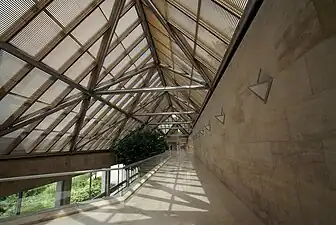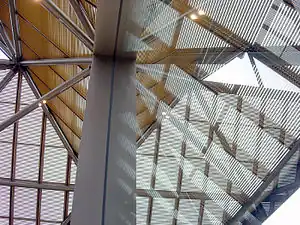ミホ ミュージアム | |
 Miho Museum In Autumn | |
 Miho Museum  Miho Museum (Japan) | |
| Established | 1997 |
|---|---|
| Location | 300 Momoya Shigarakicho Tashiro, Koka-shi, Shiga-ken 529-1814 |
| Coordinates | 34°54′52.6″N 136°01′22.4″E / 34.914611°N 136.022889°E |
| Architect | I. M. Pei |
| Website | www |
The Miho Museum (Japanese: ミホ ミュージアム, romanized: Miho myūjiamu) is located southeast of Kyoto, Japan, in the Shigaraki neighborhood of the city of Kōka, in Shiga Prefecture. It is also the headquarters of the Shinji Shumeikai, a new religious group founded by Mihoko Koyama.
History
The museum was the dream of Mihoko Koyama (after whom it is named), founder of the religious organization Shinji Shumeikai[1] which is now said to have some 300,000 members worldwide.[2] Furthermore, in the 1990s Koyama commissioned the museum to be built close to the Shumei temple in the Shiga mountains. Meanwhile, the Church of World Messianity (世界救世教, Sekai Kyūseikyō), the parent organization from which this Shumeikai came, had opened the "stunning" MOA Museum of Art in the mountains behind Atami in 1982.[3]
Since its opening in 1997, the museum has been run by the Shumei Cultural Foundation. Takeshi Umehara, a scholar of philosophy and religion, served as the museum's first director.[4]
Collection
The Miho Museum collection began with Japanese art, including Shinto and Buddhist art, paintings, ceramics, lacquerware and tea ceremony utensils, collected by Mihoko Koyama for over 40 years. The collection consists of 3,000 pieces of Japanese and Oriental art, of which 250 to 300 are on display at any one time. Special exhibitions of Japanese art from the collection are held several times a year in the North Wing, and permanent exhibitions of other areas are held in the South Wing.[5][6][7][8]
As of March 2022, the museum owns six[8] of the more than 10,000 Important Cultural Properties of arts and crafts designated by the Japanese government.[9] These included two Buddhist statues,[10][11] a Buddhist painting,[12] a Buddhist scripture,[13] a quiver,[14] and a tea bowl.[15] In November 2022, the Japanese government announced the designation of three hanging scrolls in the museum's collection as Important Cultural Properties. This brings the total number of Important Cultural Properties in the museum's collection to nine. Two of the hanging scrolls were made by cutting out sections of the emakimono (picture scroll) Chōjū-jinbutsu-giga and reworking them into hanging scrolls. The other is a hanging scroll from the Masuda family's emakimono Jigoku zoshi (ja), which was cut out and reworked into hanging scrolls.[16]
The museum's collection also includes Zo to kujira-zu byōbu (Elephant and Whale), a late masterpiece by Itō Jakuchū, one of Japan's most popular painters. This work made headlines in Japan in 2008 when it was discovered in an old house in the Hokuriku region.[17]
L.jpg.webp)
R.jpg.webp) Zo to Kujira-zu byōbu (right panel), Itō Jakuchū, 1796
Zo to Kujira-zu byōbu (right panel), Itō Jakuchū, 1796
Among the objects in the collection are more than 1,200 objects that appear to have been produced in Achaemenid Central Asia.[18] Some scholars have claimed these objects are part of the Oxus Treasure, lost shortly after its discovery in 1877 and rediscovered in Afghanistan in 1993.[19] The presence of a unique findspot for both the Miho acquisitions and the British Museum's material, however, has been challenged.[20]
Many of the items in the collection were acquired in collaboration with the art dealer Noriyoshi Horiuchi over the course of just six years,[21] and some have little or no known provenance.[22][23] In 2001 the museum acknowledged that a sixth-century statue of a Boddhisatva in its collection was the same sculpture which been stolen from a public garden in Shandong province, China, in 1994, agreeing with the Chinese government to return it in 2007. At the time of the agreement, the Chinese government publicly stated that the museum had purchased the Buddha statue in good faith on the open market and had not committed any fraud.[24][25]
Highlights of the collections have been featured in traveling exhibitions at the Los Angeles County Museum of Art and the Metropolitan Museum of Art in 1996,[26] as well as the Kunshistorisches Museum Wien in 1999.[27]
Architecture
Mihoko Koyama and her daughter, Hiroko Koyama, commissioned the American architect I. M. Pei to design the Miho Museum. Pei's design, which he came to call Shangri-La, is executed in a hilly and forested landscape.[28] Approximately three-quarters of the 17,400 square meter building is situated underground, carved out of a rocky mountaintop.[29] The roof is a large glass and steel construction, while the exterior and interior walls and floor are made of a warm beige-colored limestone from France – the same material used by Pei in the reception hall of the Louvre. The structural engineer for this project was Leslie E. Robertson Associates.
Pei continued to make changes to the design of the galleries during construction as new pieces were acquired for the collection.[30]
Pei had earlier designed the bell tower at Misono,[31] the international headquarters and spiritual center of the Shumei organization. The bell tower can be seen from the windows of the museum.
 I. M. Pei's interior style in Miho museum
I. M. Pei's interior style in Miho museum I. M. Pei's interior style in Miho museum
I. M. Pei's interior style in Miho museum
See also
- MOA Museum of Art - An art museum that collects and exhibits the collection of Mokichi Okada.
- Antiquities trade
Notes
- ↑ Lindelauf, Perrin (March 8, 2009). "Luck, trickery and treasure in Koka City". Retrieved 26 August 2014.
- ↑ "Encyclopedia of Shinto".
- ↑ "Creating a museum as a sacred, powerful place". The Japan Times. 27 July 2022. Archived from the original on 8 January 2019. Retrieved 3 June 2023.
- ↑ "Concept A Real-World Shangri-La". Miho Museum. Archived from the original on 24 March 2023. Retrieved 31 May 2023.
- ↑ "Promoting Beauty, Peace and Joy Through Art". Miho Museum. Archived from the original on 27 March 2023. Retrieved 31 May 2023.
- ↑ 美の祈り Universal Symphony (in Japanese). Bijutsu Techo. Archived from the original on 29 March 2023. Retrieved 31 May 2023.
- ↑ 【レビュー】「美の祈り Universal Symphony」展 MIHO MUSEUM(滋賀県甲賀市)で6月11日まで (in Japanese). The Yomiuri Shimbun. 24 April 2023. Archived from the original on 24 April 2023. Retrieved 31 May 2023.
- 1 2 現代の桃源郷に広がる建築美と貴重な古代美術品の魅力に浸る (in Japanese). Discover Japan Inc. 4 March 2023. Archived from the original on 29 January 2023. Retrieved 31 May 2023.
- ↑ 文化財指定等の件数 (in Japanese). Agency for Cultural Affairs. 5 April 2023. Archived from the original on 28 April 2023. Retrieved 29 April 2023.
- ↑ "Standing Jikokuten". Miho Museum. Archived from the original on 31 May 2023. Retrieved 31 May 2023.
- ↑ 地蔵菩薩立像 (in Japanese). The Agency for Cultural Affairs. Archived from the original on 30 March 2023. Retrieved 31 May 2023.
- ↑ "Enmaten". Miho Museum. Archived from the original on 31 May 2023. Retrieved 31 May 2023.
- ↑ 紫紙金字金光明最勝王経巻第二 (in Japanese). The Agency for Cultural Affairs. Archived from the original on 31 May 2023. Retrieved 31 May 2023.
- ↑ 紫檀螺鈿宝相華鳳凰文平胡籙 (in Japanese). The Agency for Cultural Affairs. Archived from the original on 3 February 2023. Retrieved 31 May 2023.
- ↑ 耀変天目 (in Japanese). The Agency for Cultural Affairs. Archived from the original on 29 January 2023. Retrieved 31 May 2023.
- ↑ 文化審議会の答申(国宝・重要文化財(美術工芸品)の指定等) (PDF) (in Japanese). The Agency for Cultural Affairs. 18 November 2022. pp. 17, 18, 19. Archived from the original (PDF) on 22 November 2022. Retrieved 31 May 2023.
- ↑ キーパーソンに訊く 若冲ブーム (in Japanese). Wedge Online. 8 September 2009. Archived from the original on 29 May 2023. Retrieved 31 May 2023.
- ↑ Curtis, John (1 September 2004). "The Oxus Treasure in the British Museum". Ancient Civilizations from Scythia to Siberia. 10 (3): 334. doi:10.1163/1570057042596397.
- ↑ Southampton, Kathy Judelson; Pichikyan, I.R. (1 January 1998). "Rebirth of the Oxus Treasure: Second Part of the Oxus Treasure From the Miho Museum Collection". Ancient Civilizations from Scythia to Siberia. 4 (4): 306–383 [308–309]. doi:10.1163/157005797X00126.
- ↑ Muscarella, Oscar White (1 November 2003). "Museum Constructions of the Oxus Treasures: Forgeries of Provenience and Ancient Culture". Ancient Civilizations from Scythia to Siberia. 9 (3): 259–275. doi:10.1163/157005703770961778.
- ↑ Melikian, Souren (November 6, 1997). "A Splendid Art Collection Goes On Display in Japan". Retrieved 26 August 2014.
- ↑ Hoffman, Barbara T., ed. (2006). Art and Cultural Heritage: Law, Policy and Practice. Cambridge University Press. pp. 54f. ISBN 978-0-521-85764-2.
- ↑ McCurry, Justin (11 January 2007). "Italy to ask Japan for return of 'looted' antiques". The Guardian. Retrieved 8 March 2012.
- ↑ Sims, Calvin (April 18, 2001). "Japanese Agree A Stolen Statue Will Be Sent Back to China". Archived from the original on 27 August 2014. Retrieved 26 August 2014.
- ↑ Abe, Stanley (2002). "Review: Return of the Buddha: The Qingzhou Discoveries by Lukas Nickel". Artibus Asiae. 62 (2): 296. doi:10.2307/3250269. JSTOR 3250269.
- ↑ Arnold, Dorothea (1996). Ancient art from the Shumei Family collection. New York: Metropolitan Museum of Art. ISBN 9780870997730. OCLC 34286025.
- ↑ Seipel, Wilfried (1999). Schätze des Orients: Meisterwerke aus dem Miho Museum. Milan, Wien: Skira; Kunsthistorisches Museum Wien. ISBN 9783854970033. OCLC 42651340.
- ↑ Baker, Kenneth (18 November 2007). "Miho Lets Art Speak For Itself". The San Francisco Chronicle.
- ↑ Rosenblatt, Arthur (2001). Building type basics for museums. John Wiley and Sons. pp. 32. ISBN 0-471-34915-1.
shinji shumeikai.
- ↑ Dobrzynski, Judith (August 28, 2013). "A Trek Well Worth Taking". Retrieved 26 August 2014.
- ↑ "Shumei – Art and Beauty". Archived from the original on 2015-12-26. Retrieved 2010-11-24.